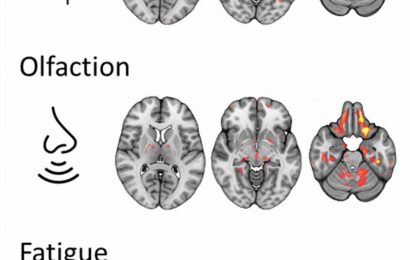Study finds examining retinal structure could provide markers for Parkinson disease
The neurodegenerative changes seen in the retina of people suffering from Parkinson disease (PD) have been described using cadaveric imaging. However, the corresponding changes in the living eye have not yet been reliably described.

A new paper in Neurology first examined the retinal data from a retrospective cohort of PD patients using optical coherence tomography (OCT), attempting to identify markers for the disease, that were subsequently tested in a prospective arm of the study.
Introduction
PD is a movement disorder in which the nigrostriatal pathway in the brain is affected by neuronal degeneration and subsequent loss. This can be detected decades before clinical disease appears, using brain imaging techniques such as magnetic resonance imaging (MRI) and serial dopamine transport (DAT) scanning.
The former has not been accepted as a mass screening platform yet. The latter is expensive, limited to high-end facilities, and dependent on the use of intravenous contrast dyes, making its large-scale use doubtful.
The eye is an outgrowth of the central nervous system and is easily imaged with high-resolution imaging devices. The nervous part of the retina contains dopaminergic cells in the inner plexiform layer (IPL) and inner nuclear layer (INL).
Since people with PD have been shown to have lower-than-expected dopamine content in their retinas after death, in vivo imaging techniques have been explored to confirm the presence of in vivo changes.
OCT is one such technique that is based on interference phenomena, without physical contact with the eye. It is becoming more widely available and can potentially offer the ability to diagnose or provide a prognosis for multiple neurological conditions.
Existing studies are often contradictory in their findings. Moreover, confounding comorbidities are often not included in such studies, though they affect the natural history of PD.
However, a review of ten studies indicated thinning of the macular retinal nerve fiber layer (mRNFL) and the ganglion cell-inner plexiform layer (GCIPL). The opposite was true of the INL. The current study thus attempted to identify associations between retinal imaging data and PD, both before and after the diagnosis.
What did the study show?
The retrospective data from the first study came from AlzEye, including over 150,000 patients aged 40 years or more. There were 700 PD patients with a mean age of ~66 years, almost equally male or female. This helped pick up PD markers in the retina.
Secondly, they looked at incident PD, using data from the UK Biobank. This contained retinal imaging data from over 50,000 individuals between 40 and 69 years of age.
The researchers extracted data on the thickness of the retina at the following key sites: macular retinal nerve fiber layer (mRNFL), ganglion cell-inner plexiform layer (GCIPL), and INL, using fovea-centered OCT data.
They explored the presence of associations between prevalent PD and retinal thickness. They also estimated the change in risk for PD over time at various retinal thicknesses.
There were 700 PD patients in the AlzEye cohort with a mean age of ~66 years, with equal numbers of either sex. Individuals who already had PD were at higher odds to be male, and to be hypertensive and diabetic.
Even after adjusting for these risk factors, PD patients showed thinning of the GCIPL, and the INL, by over 2 μm and just under 1 μm, respectively. The inferior subfield was the most affected part of the GCIPL vs the superior subfield for the INL.
After excluding all diabetics, the remaining 344 PD patients still showed the same associations with a somewhat smaller effect size.
In the UK Biobank cohort, of the >50,000 participants, slightly over half were women, with the mean age being 56 years. There were 53 new PD cases. The time to PD diagnosis was ~2,600 days on average.
PD cases were more likely to be older males. Both GCIPL and INL thickness were reduced in these patients. The association with higher PD risk continued to be seen even after removing all new cases diagnosed within the first two years of retinal OCT.
The risk of PD went up with each standard deviation (SD) of thinning. Thus, with each SD increase in the GCIPL, the risk was almost 40% lower. Correspondingly, each SD increase in the INL thickness reduced the risk by 30%.
The observation of such changes in the retina several years before the disease presents clinically raises the possibility of using OCT imaging in identifying individuals at high risk for PD.
What are the implications?
The study confirms earlier reports that the GCIPL is markedly thinner in patients with PD and adds the finding of INL thinning as well for the first time. The INL is the focus of dopaminergic neuronal signaling within the nervous part of the retina, connecting bipolar cells with amacrine (the primary dopaminergic cells here) and horizontal cells.
The findings also show an association between thinning of the GCIPL, and also of the INL to a smaller extent, with a higher risk of developing PD. This association holds good even after compensating for sex, age, race of origin, and comorbidities like diabetes and hypertension.
The INL thinning may be due to the build-up of toxic protein clumps in the PD pathophysiologic process, causing oxidative stress and mitochondrial damage. The resulting influx of calcium ions could lead to a deficient energy supply, killing the neurons. This explains why other neurological illnesses that do not involve dopaminergic neurons fail to show INL thinning.
The reduction in GCIPL thickness is probably the result of neurodegeneration beginning with the white matter or axonal changes. This could be primary, or secondary to the loss of dopaminergic signaling in the INL. Dopaminergic neurons are packed mostly in the parafoveal region studied here.
Further research is required to elucidate the mechanism of GCIPL atrophy.
Collectively, these findings strengthen the argument that neurodegenerative pathology in Parkinson disease involves the GCIPL and INL and that these retinal layers may have prognostic clinical relevance.
Wagner et al. (2023)
- Wagner SK et al. (2023). Retinal Optical Coherence Tomography features associated with incident and prevalent Parkinson disease. Neurology. doi: 10.1212/WNL.0000000000207727. https://n.neurology.org/content/early/2023/08/21/WNL.0000000000207727.
Posted in: Device / Technology News | Medical Science News | Medical Research News | Medical Condition News | Disease/Infection News
Tags: Brain, Calcium, Cell, Central Nervous System, Diabetes, Dopamine, Dopaminergic, Eye, Ganglion, Imaging, Imaging Techniques, in vivo, Magnetic Resonance Imaging, Movement Disorder, Nerve, Nervous System, Neurodegeneration, Neurology, Neurons, OCT, Optical Coherence Tomography, Oxidative Stress, Pathology, Protein, Research, Stress, Tomography, UK Biobank

Written by
Dr. Liji Thomas
Dr. Liji Thomas is an OB-GYN, who graduated from the Government Medical College, University of Calicut, Kerala, in 2001. Liji practiced as a full-time consultant in obstetrics/gynecology in a private hospital for a few years following her graduation. She has counseled hundreds of patients facing issues from pregnancy-related problems and infertility, and has been in charge of over 2,000 deliveries, striving always to achieve a normal delivery rather than operative.


